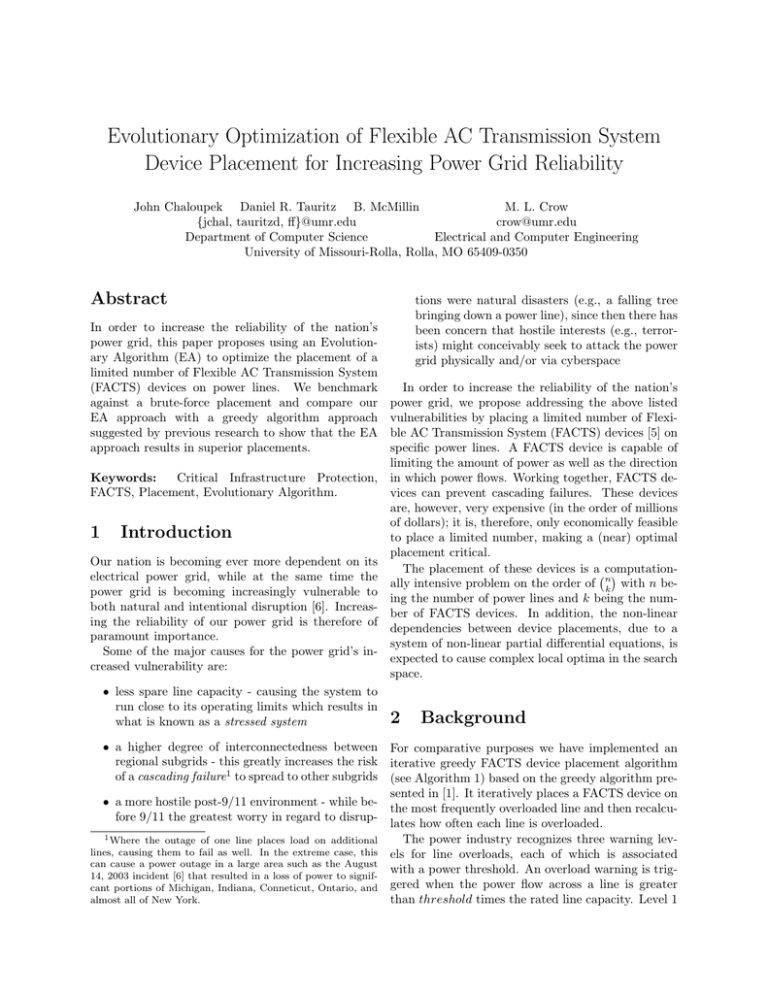Evolutionary Optimization of Flexible AC Transmission System
advertisement

Evolutionary Optimization of Flexible AC Transmission System
Device Placement for Increasing Power Grid Reliability
John Chaloupek Daniel R. Tauritz B. McMillin
M. L. Crow
{jchal, tauritzd, ff}@umr.edu
crow@umr.edu
Department of Computer Science
Electrical and Computer Engineering
University of Missouri-Rolla, Rolla, MO 65409-0350
Abstract
In order to increase the reliability of the nation’s
power grid, this paper proposes using an Evolutionary Algorithm (EA) to optimize the placement of a
limited number of Flexible AC Transmission System
(FACTS) devices on power lines. We benchmark
against a brute-force placement and compare our
EA approach with a greedy algorithm approach
suggested by previous research to show that the EA
approach results in superior placements.
Keywords:
Critical Infrastructure Protection,
FACTS, Placement, Evolutionary Algorithm.
1
Introduction
Our nation is becoming ever more dependent on its
electrical power grid, while at the same time the
power grid is becoming increasingly vulnerable to
both natural and intentional disruption [6]. Increasing the reliability of our power grid is therefore of
paramount importance.
Some of the major causes for the power grid’s increased vulnerability are:
• less spare line capacity - causing the system to
run close to its operating limits which results in
what is known as a stressed system
tions were natural disasters (e.g., a falling tree
bringing down a power line), since then there has
been concern that hostile interests (e.g., terrorists) might conceivably seek to attack the power
grid physically and/or via cyberspace
In order to increase the reliability of the nation’s
power grid, we propose addressing the above listed
vulnerabilities by placing a limited number of Flexible AC Transmission System (FACTS) devices [5] on
specific power lines. A FACTS device is capable of
limiting the amount of power as well as the direction
in which power flows. Working together, FACTS devices can prevent cascading failures. These devices
are, however, very expensive (in the order of millions
of dollars); it is, therefore, only economically feasible
to place a limited number, making a (near) optimal
placement critical.
The placement of these devices is a computation
ally intensive problem on the order of nk with n being the number of power lines and k being the number of FACTS devices. In addition, the non-linear
dependencies between device placements, due to a
system of non-linear partial differential equations, is
expected to cause complex local optima in the search
space.
2
Background
• a higher degree of interconnectedness between For comparative purposes we have implemented an
regional subgrids - this greatly increases the risk iterative greedy FACTS device placement algorithm
of a cascading failure1 to spread to other subgrids (see Algorithm 1) based on the greedy algorithm presented in [1]. It iteratively places a FACTS device on
• a more hostile post-9/11 environment - while bethe most frequently overloaded line and then recalcufore 9/11 the greatest worry in regard to disruplates how often each line is overloaded.
1 Where the outage of one line places load on additional
The power industry recognizes three warning levlines, causing them to fail as well. In the extreme case, this els for line overloads, each of which is associated
can cause a power outage in a large area such as the August
with a power threshold. An overload warning is trig14, 2003 incident [6] that resulted in a loss of power to signifcant portions of Michigan, Indiana, Conneticut, Ontario, and gered when the power flow across a line is greater
than threshold times the rated line capacity. Level 1
almost all of New York.
Algorithm 1 Iterative Greedy FACTS Placement
P ←∅
l ← number of lines
f ← number of FACTS devices
for F ACT S = 1 to f do
LO[i] = 0, i ∈ 1 . . . l
for SLC = 1 to l do
LF ← P ower F low M odel(P )
for k = 1 to l do
if LF [k] > threshold · LC[k] then
LO[k] ← LO[k] + 1
end if
end for
end for
P ← P ∪ ArgM ax(LO[i]), i ∈ 1 . . . l
end for
(threshold = 1.0) is the lowest warning level, where
the system can remain operational but needs to be
closely watched, Level 2 (threshold = 1.1) is the next
warning level, where the system can still operate for
a reasonable period of time but action needs to be
taken. Level 3 (threshold = 1.2) is an emergency
level, where lines will begin to burn out if nothing is
done quickly.
The greedy algorithm works as follows for a given
power system, where LC is an array containing that
system’s line capacities. The set P of line numbers indicating placed FACTS devices is initalized to empty,
while l and f are initialized to the number of power
lines and the number of FACTS devices to be placed,
respectively. The algorithm works by iterating over
the number of FACTS devices to be placed. LO is
an array that keeps the tally of how many times each
line has been overloaded in the current iteration. It
gets reset to zero for each iteration. This tally is increased each time a line is overloaded, for every Single
Line Contingency (SLC)2 . Overloads are determined
by running P ower F low M odel(P ) —which is an implementation of the powerflow algorithm described
in [4]— on the system for the current P , assigning
the computed power flow values for each line to the
array LF , and for each line comparing these values
with threshold times that line’s capacity. The most
frequently overloaded line is determined at the end
of each iteration. Placement of a FACTS device on
that line is indicated by adding the line number to
P . After the final iteration, P contains the greedy
algorithm’s FACTS placement solution in the form
of a set of line numbers.
2 An
SLC is the outaging of a single line.
Table 1: EA Specifics
Representation
Var. Length Integer Sequence
Initialization
Uniform Randomly
Parent Selection Linear Rank Based
Recombination
Custom (see Subsection 3.1)
Mutation
Custom (see Subsection 3.2)
Competition
Elitist Stochastic (µ + λ)
Termination
Fixed # of Generations
3
Evolutionary Algorithm
The specifics of our EA are summarized in Table 1.
In its most general form, an individual encodes the
placement of an arbitrary number of FACTS devices;
this is represented by a variable length integer sequence with each integer specifying a line number. A
restricted form, in which an individual encodes the
placement of a prespecified number of FACTS devices, was also implemented; this is particularly useful for plotting the aggregate number of overloaded
lines versus the number of FACTS devices (see Section 4). The remaining EA details are explained in
the following subsections.
3.1
Reproduction
Individuals are selected stochastically from the population pool according to the linear rank formula presented in Section 25.2 of [2]:
αrank +
P rrank (i) =
h
rank(i)
(µ−1)
i
µ
(βrank − αrank )
(1)
where µ is the population size, rank(i) is the rank of
individual i where 0 is least fit and µ − 1 is most fit,
αrank is the expected number of offspring for the least
fit member and can be shown to be equal to 2−βrank ,
and βrank is the expected number of offspring for the
fittest member. βrank is a user adjustable parameter
that can be varied between 1.0 and 2.0, higher values
producing a steeper curve; we chose 2.0 in order to
obtain high selective pressure.
When an individual is selected to reproduce, it
will recombine with chance Pc with another member, rather than simply being cloned. In recombination, each individual FACTS device placement from
both parents has a 50% chance of being passed on to
the offspring. If the number of FACTS placements
has been prespecified, the list is either truncated or
padded with random placements as required.
Table 2: Parameter Sets
Param. Set
Pc
Pm
µ
λ
EA1
0.20 0.50 100 2
EA2
0.90 0.90 100 4
Figure 1: Examples of neighboring lines (left) and
neighboring FACTS placements (right).
From:
2
5
3
2
4
5
3
Gens
100
100
4
Table 3: Aggregate Level 1 Overloads
FACTS
Line (3,4)
3
5
4
FACTS 3
4
1
Neighbors of
Line (3,4)
3.2
1
Mutation
Each offspring is selected with chance Pm for mutation, in which each individual FACTS placement has
a 1/n chance of being moved, where n is the number
of FACTS placements in that member. Thus, while
on average one FACTS placement is moved per mutation, there is a chance for multiple placements to
be moved. This prevents the EA from getting stuck
in local optima from which the movement of a single
placement would not be sufficient to escape.
FACTS placement movement is performed according to the system’s topology. A line is a neighbor
of another line when it shares a bus with that line.
A FACTS placement, when chosen for mutation, is
randomly moved from the line it is on to one of its
neighbors3 , as shown in Figure 1.
3.3
Evaluation
To evaluate an individual, P ower F low M odel(P ) is
run on the system for the set of FACTS placements it
encodes. An individual’s fitness is inversely proportional to the aggregate number of overloads over all
SLCs (different types of overloads can be specified by
choosing the appropriate threshold value). Running
P ower F low M odel(P ) is numerically intensive: it
takes on the order of a minute to execute on a Pentium P4 for a small system like the IEEE 118 bus test
system [3] which contains only 179 lines.
3 note
that in our definition of neighboring line, a line is its
own neighbor
3.4
EA2 Avg
2
EA2 Best
To:
EA1 Avg
5
EA1 Best
2
Greedy
1
# FACTS
1
1
2
3
4
5
6
7
8
9
10
41
40
40
40
40
40
40
39
39
38
37
35
34
34
34
32
30
31
29
31
38.2 (1.10)
36 (1.22)
35.4 (1.14)
35.8 (1.30)
34.6 (.55)
33.2 (1.30)
31.8 (1.10)
31.8 (.45)
30.4 (.89)
31.2 (.45)
37
35
34
31
31
31
30
29
28
26
37 (0.00)
35 (0.00)
34.6 (.89)
32.4 (1.14)
31.6 (.55)
31.8 (.45)
30.4 (.89)
29.8 (.84)
29.4 (.89)
27.6 (1.14)
Competition
Of the combined population and offspring pool, λ individuals are selected for elimination employing the
inverted version (fittest individual ranked lowest instead of highest) of the linear rank based model
used for reproduction, again with βrank held at 2.0.
This model constitutes an Elitist approach, since the
fittest member has a zero probability of being chosen.
4
Experimental Results
We compared the performance of our EA to that of
the Iterative Greedy FACTS Placement algorithm on
the aforementioned IEEE 118 bus system. For performance measure we chose minimizing the aggregate
number of Level 1 overloads (see Section 2); therefore threshold was set to 1.0 for both the greedy algorithm and our EA’s fitness function. We report
results for the two EA parameter sets specified in
Table 2. Parameter set EA1 was our initial parameter set; it was designed to produce high selective
pressure in order to minimize the number of evaluations required in light of the high computational cost
of evaluation. After studying the effects of varying
various of the parameters, we eventually arrived at
parameter set EA2. The results for parameter sets
EA1 and EA2 as well as for the greedy algorithm are
provided in Table 3. Results are reported for one
L1 Aggregate Overloads
vices. The EA presented in this paper was demonFigure 2: Comparison of selected algorithms on the
strated to be superior to the Iterative Greedy FACTS
IEEE 118 bus test system.
Placement algorithm suggested in previously published work. The customized recombination and mutation operators proved effective for this particular
45
placement problem and are expected to be similarly
effective on other placement problems.
40
35
6
30
Brute Force
Greedy
EA1
EA2
25
There are many possible avenues of research leading
from the above discussion. Some we plan to investigate in the near future are:
20
0
1
2
3
Future Work
4
5
6
# FACTS Devices
7
8
9
10
• Study the scalability of our EA by applying it to
larger IEEE test systems.
• Parallelize our approach in order to utilize a grid
computing cluster.
through ten FACTS devices (with the number pre• Switch to a more realistic fitness function which
specified for the EA). Due to the high computational
balances minimizing the aggregate number of
cost of the fitness function, only five runs were peroverloaded lines and minimizing the aggregate
formed on each parameter set. The columns EA1
amount of overloaded power (the greater a line’s
Best and EA2 Best contain the best results found
capacity, the more important that it not be overover all five runs, while columns EA1 Avg and EA2
loaded).
Avg list the average best results; standard deviations
are indicated in parentheses.
The results are plotted in Figure 2. The graph References
shows the baseline number of overloads before any
FACTS devices are placed, which is 41. The graph [1] Armbruster, A., McMillin, B., and Crow,
also displays the result of an exhaustive search for one
M. L. Controlling power flow using FACTS deFACTS placement, which is 37 overloads, and for two
vices and the max flow algorithm. In Proceedings
FACTS placements, which is 35 overloads. While it
of the International Conference on Power Sysis not feasible to perform an exhaustive search for
tems and Control (December 2002).
higher numbers of FACTS devices, it is encouraging
that for both parameter sets the EA found the op- [2] Bäck, T., Fogel, D. B., and Michalewicz,
Z., Eds. Evolutionary Computation 1: Basic Altimal placement for one or two FACTS devices. Pagorithms and Operators. Institute of Physics Pubrameter set EA2 is clearly superior to EA1, while in
lishing, Bristol, 2000.
both cases the EA obviously outperforms the greedy
algorithm.
[3] Christie, R. Power systems test case archive:
118 bus power flow test case, May 1993.
5
Conclusions
[4] Crow, M. L. Computational Methods for Electric Power Systems. CRC Press, 2003.
The increasing dependence of our nation on its power
grid makes the robustness and integrity of the power [5] Hingorani, N. G., and Gyugyi, L. Ungrid ever more critical. The placement of power regderstanding FACTS: Concepts and Technology of
ulation devices, such as FACTS devices, is an imporFlexible AC Transmission Systems. IEEE Press,
tant tool for protecting power grids from catastrophic
2000.
failures. Placement is critical for obtaining optimal
benefits from these devices. Prohibitively high costs [6] U. S. DOE. Initial blackout timeline of the august 14, 2003 outage, 2003.
for FACTS devices make it essential to obtain the
maximum benefit from the minimum number of de-





